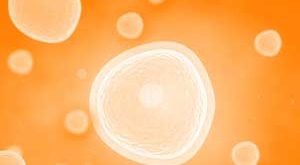
Enzyme-linked immunosorbent assay (ELISA) is a method allowing the quantification of a desired marker in a biological sample. Achieving high quality quantification data by ELISA can be very advantageous when compared to more qualitative methods like IHC and Western blotting. For ELISA users, having a low coefficient of variability (CV or %CV) between sample replicates is crucial in demonstrating an assay was well-run and the resultant data is precise and accurate. Reliable assay results are assessed by standardized measures such as coefficient of variability.

Figure 1. General mathematical
formula for Coefficient
of Variability (CV).
The coefficient of variability is a dimensionless numerical ratio used to describe the level of variability within a population independently of the absolute values of the observations. In statistical analysis of numerical data, if your absolute values are similar, sample populations can be assessed by using standard deviations; when absolute values vary, you must consider using a more standardized approach such as %CV, to assess the precision of a laboratory technique. CV is calculated by dividing the standard deviation (σ) of a set of measurements by the mean (µ) of the set which is then expressed as a percentage of variation to the mean (Figure 1).
In ELISA data interpretation, %CV can highlight inconsistencies among sample replicates which is demonstrated in the data as variation among Optical Density (OD) readouts post-assay. These directly reflect the performance of the assay in the hands of the end-user. There are two types of %CVs that are used to express the precision of immunoassay results: intra-assay CV and inter-assay CV. Intra-assay CV is a measure of the variance between data points within an assay, meaning sample replicates ran within the same plate. Inter-assay CV is a measure of the variance between runs of sample replicates on different plates that can be used to assess plate-to-plate consistency. As a general guideline, to gauge the overall reliability of your immunoassay results, inter-assay %CV should be less than 15% while intra-assay %CV should be less than 10%.
It is important to identify the causes of high %CV in ELISAs. Human technical error can play a role such as inaccurate pipetting technique, splashing of reagents between wells, drying out of the wells, inconsistent sample handling (variability due to freeze-thaw cycles among samples), and use of differing filter settings to start. Additionally, high %CV can be the result of machine error such as usage of uncalibrated automated machine pipettes, uncalibrated plate readers, and inappropriate plate reader software settings to analyze samples in wells. Lastly, plate, sample, and reagent contamination can lead to a high %CV. Cross-contamination between reagents can occur from handling errors leading to bacterial or fungal contamination of samples and reagents derived from compromised sterility. To reduce %CV between your sample replicate ODs would mean to reduce the incidence of these common sources of error.
In regards to both inaccurate pipetting and contamination, using fresh pipette tips for each addition is one common practice. Discarding old tips for new tips between each addition can prevent cross-contamination between wells which can keep the background and %CV low amongst your sample replicates. Also, it is not recommended to pour excess reagent from a reservoir back into the original bottle as this can unintentionally contaminate your stock solution which will be reflected in your readouts and may produce a high %CV. In regards to technique, pre-wetting pipette tips 2-3 times in the solution that is to be pipetted also can help to improve %CV. If using mechanical air-displacement pipettes, practicing proper technique is important to minimize %CV. Some general practices include holding the pipette vertically and not at an angle, aspirating slowly and smoothly, having the tip touching the vessel when withdrawn to avoid extra liquid outside the tip, and making sure the tip is placed just under the surface of the liquid in the reservoir when dispensing. Consistency with your aspiration point in the reservoir across duplicates may help to reduce %CV. Regular performance checking by the end-user or a service technician should be prioritized as well to ensure both mechanical and machine pipettes are calibrated. This can go a long way in reducing %CV. Regular re-calibration should also be a good practice that extends to other instruments including the plate washer and reader to help reduce variation from machine error that will impact CVs.
Lastly, at different steps of your protocol, opportunities to reduce %CV present themselves. During incubation, making sure plates are incubated in an environment away from drafts can minimize temperature variation across the plate and ensure even heat distribution amongst each well necessary for the analyte to bind in an equivalent manner. Another tip during incubation is to make sure plates are always covered at incubation to prevent wells from drying out and producing high %CV. During wash steps, it is important to optimize your wash protocol and maintain the same wash protocol from plate-to-plate so as to minimize inter-assay CVs. When optimizing your wash protocol, making sure the appropriate wash volume is used among duplicates and among runs of plates is necessary to reduce background. The wash volume should be greater than or equal to the coating volume. Additionally, optimizing the number of wash cycles in your protocol can help to improve signal to noise ratio. Too many wash cycles and you can reduce signal strength. Too few wash cycles and you may have too high of a background. A good rule of thumb is to repeat the wash step three times after each incubation step with antibody or antigen (if coated by end-users) but keep in mind manufacturer-coated plates may require fewer washes than plates coated by end-users. Reducing %CV in immunoassay testing is important to produce reliable, precise, and accurate data and is directly the result of paying attention to minor details during your sample handling, your protocol, and amongst the instruments you are using.
Enzo Life Sciences offers hundreds of ELISA kits all geared towards a wide variety of proteins and hormones with the option of testing multiple sample matrices from a diverse range of species. Our kits are highly published and Enzo Life Sciences has decades of experience developing and optimizing ELISA assays to meet the ever-changing needs of our scientific community. As Scientists Enabling Scientists, we realize the value in providing relevant information to our customers working in the fields of life sciences, drug development and clinical research. We are happy to provide simple yet useful tips and guidance for your research needs. Please check out our 10 Tips, ELISA Technology overview, or contact our Technical Support Team for further assistance.
| Group: | Unknown Run 1 | |||||||
| Sample | Wells | Values | Net OD | %Bound | Result | Mean Result | Std.Dev. | CV% |
| 100 | G4 | 0.541 | 0.543 | 58.68 | 18.449 | 17.172 | 1.806 | 10.5 |
| H4 | 0.565 | 0.567 | 61.276 | 15.894 | ||||
| 102 | E4 | 0.531 | 0.533 | 57.599 | 19.626 | 21.196 | 2.22 | 10.5 |
| F4 | 0.507 | 0.509 | 55.003 | 22.766 | ||||
| 103 | C4 | 0.399 | 0.401 | 43.321 | 45.333 | 41.39 | 5.576 | 13.5 |
| D4 | 0.428 | 0.43 | 46.458 | 37.447 | ||||
| 141 | A4 | 0.451 | 0.453 | 48.945 | 32.312 | 31.709 | 0.852 | 2.7 |
| B4 | 0.457 | 0.459 | 49.594 | 31.106 | ||||
| 150 | G3 | 0.471 | 51.109 | 28.482 | 26.733 | 2.473 | 9.3 | |
| H3 | 0.492 | 0.494 | 53.38 | 24.985 | ||||
| 151 | E3 | 0.45 | 0.452 | 48.837 | 32.518 | 34.155 | 2.315 | 6.8 |
| F3 | 0.435 | 0.437 | 47.215 | 35.792 | ||||
| 152 | C3 | 0.357 | 0.359 | 38.778 | 60.662 | 57.035 | 5.129 | 9 |
| D3 | 0.375 | 0.377 | 40.725 | 53.408 | ||||
| 157 | A3 | 0.362 | 0.364 | 39.319 | 58.529 | 60.036 | 2.132 | 3.6 |
| B3 | 0.355 | 0.357 | 38.561 | 61.543 | ||||
| 159 | G2 | 0.425 | 0.427 | 46.133 | 38.184 | 35.664 | 3.563 | 10 |
| H2 | 0.447 | 0.449 | 48.513 | 33.144 | ||||
Table 1. An example of high and low intra-assay %CV values from data using Aldosterone EIA Kit. Bolded in red are high% CVs (over 10) seen amongst sample replicates. Bolded in green are low %CV (underneath or at 10) seen between sample replicates.
In a scientific article it is always important to quote sources: www.enzolifesciences.com


 3V Chimica Your laboratory partner
3V Chimica Your laboratory partner 


